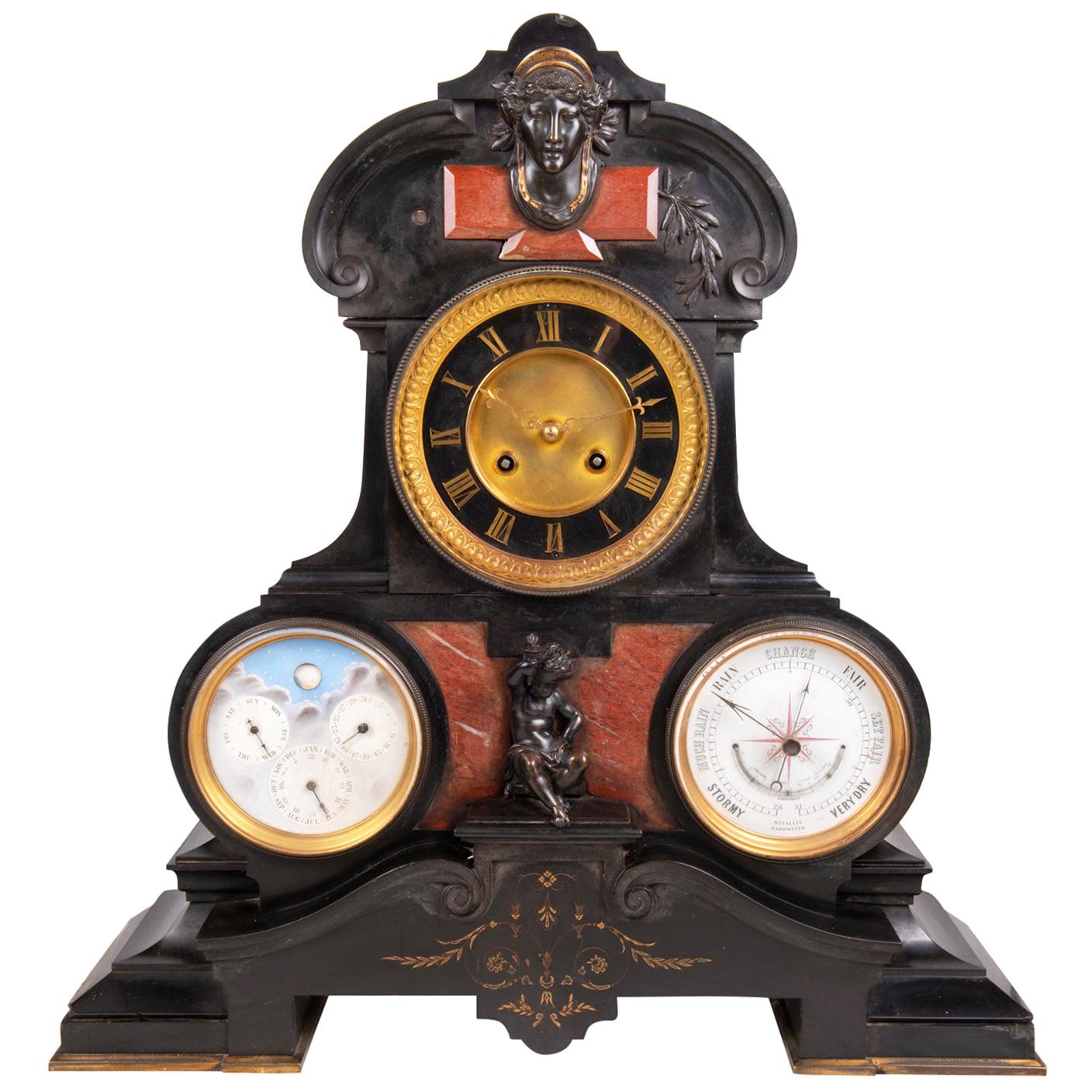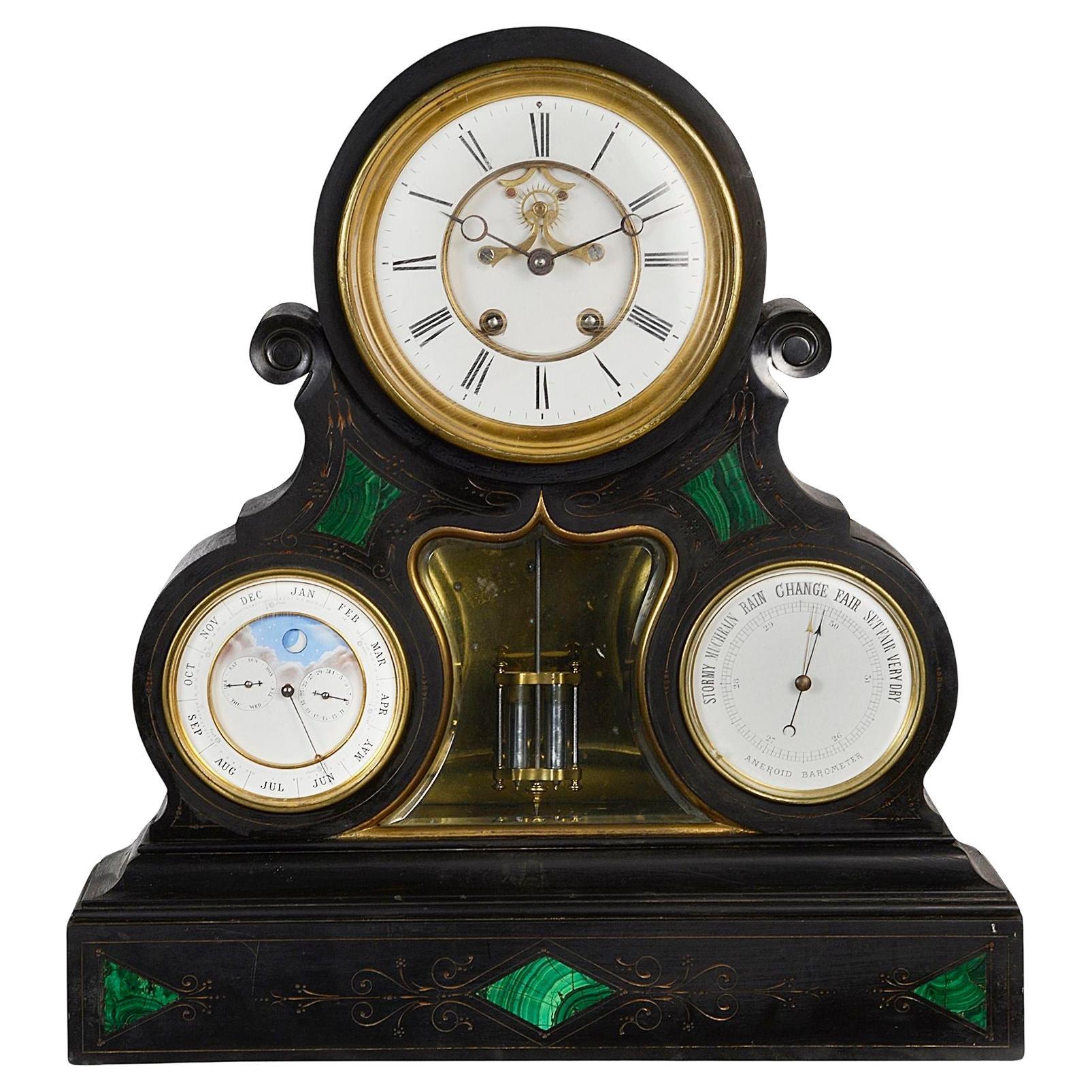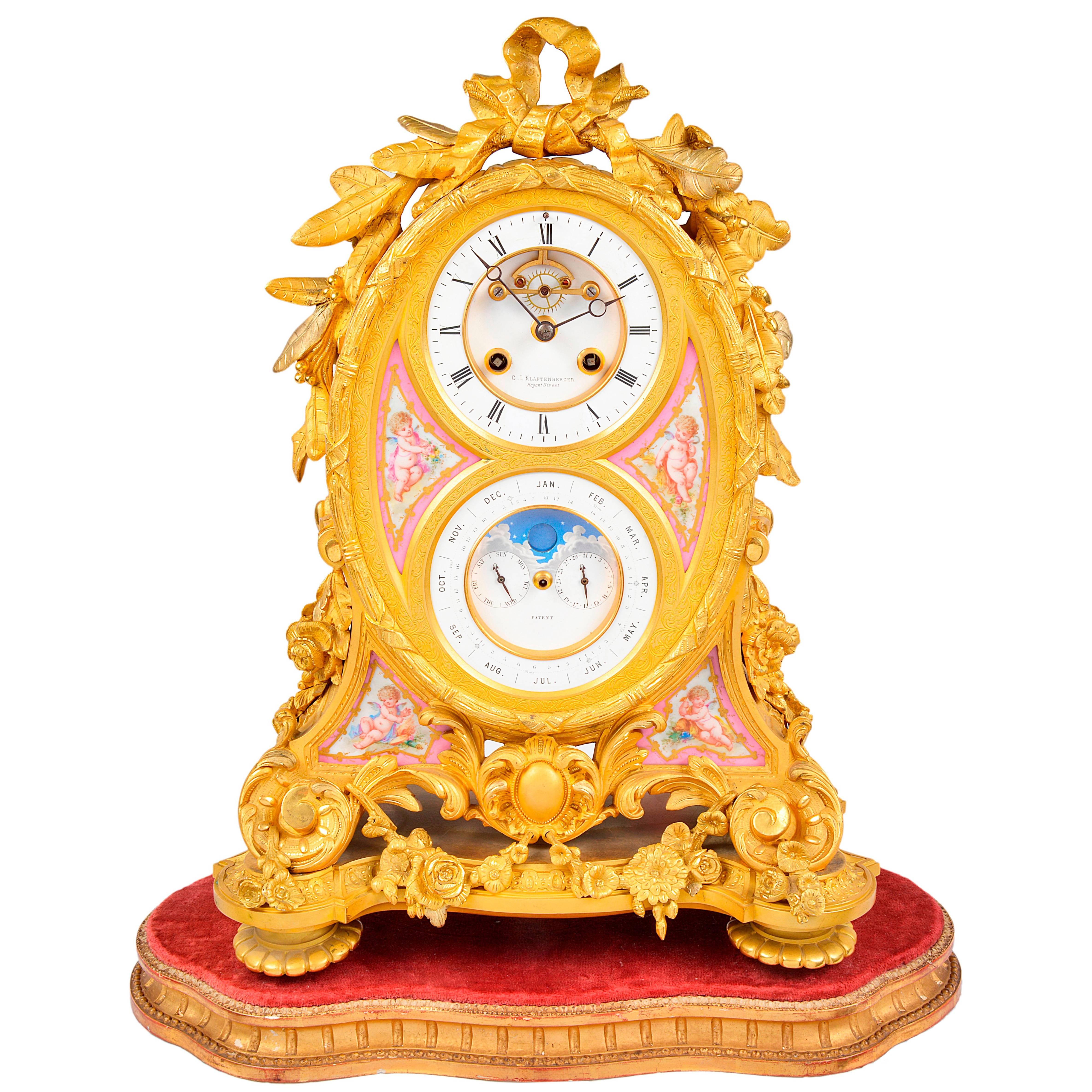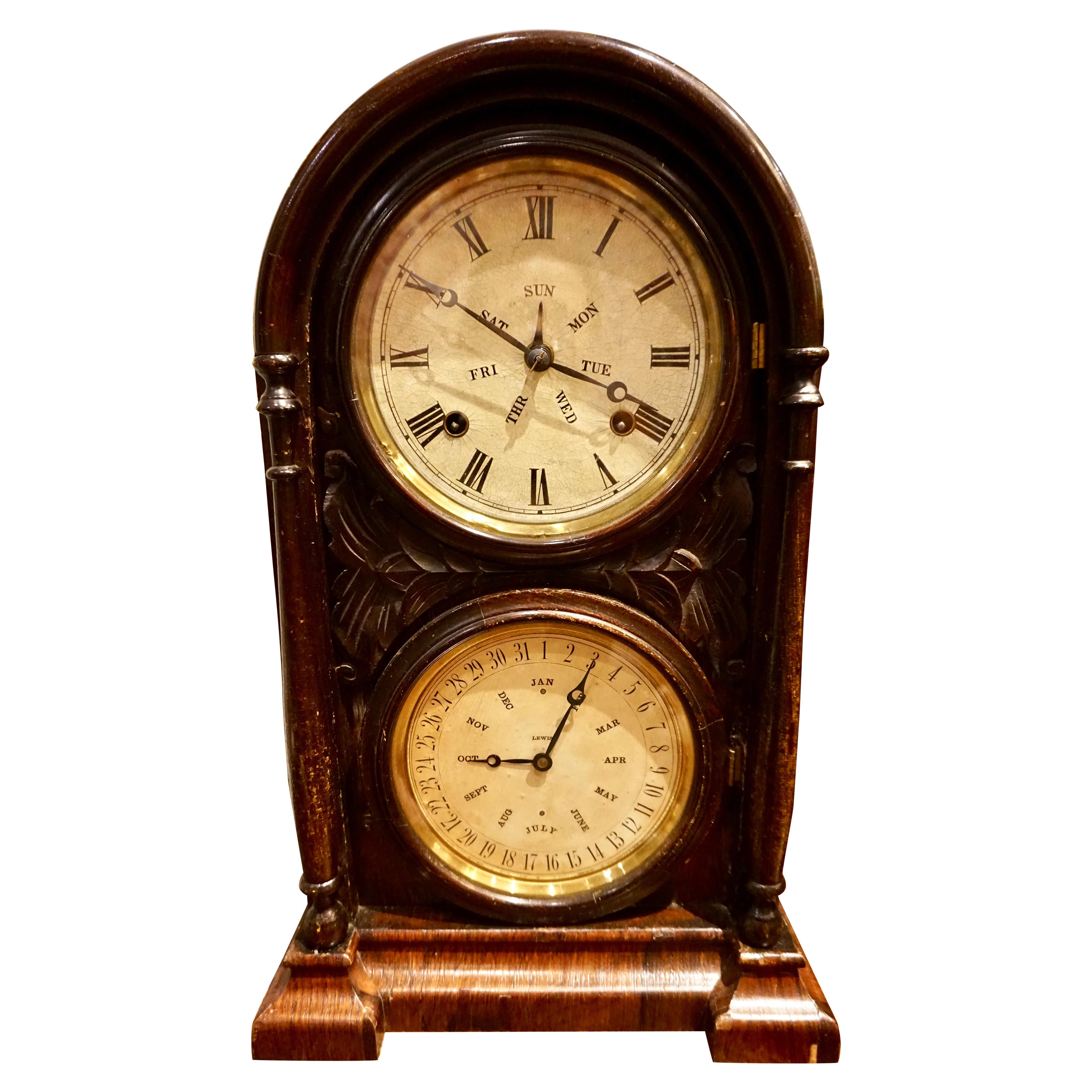Items Similar to Swiss Mantel Clock, Barometer, Moon Phase and Perpetual Calendar, 19th Century
Want more images or videos?
Request additional images or videos from the seller
1 of 8
Swiss Mantel Clock, Barometer, Moon Phase and Perpetual Calendar, 19th Century
About the Item
19th century mantel clock with moon phase and perpetual calendar
Switzerland, England
slate, enamel
circa 1870
Dimensions: 41 x 37 x 19 cm
Description:
Slate case with wide base and slightly protruding top plate.
On the front we see two mercury thermometers on top, on the left with the temperature display in Celsius, on the right in Fahrenheit.
The dial with Roman numerals, Breguet hands and an open Brocot escapement is located centrally between the thermometers. The central seconds hand is also worth mentioning.
In the outer dial ring we find two small square pins, one is used to regulate the speed, the other is used to set the time. The dial is signed: "Aubert & Klaftenberger GENEVE".
At the bottom left we see the date display, consisting of the central hand for the months and the equatorial time, as well as three decentralized displays for day of the week, moon phase and date.
In the short months with 30 or 28 days, the calendar jumps directly to the first of the following month. It also switches the leap year every four years.
Complex calendars like this one are called "perpetual calendars". Strictly speaking, however, it is "only" a 100-year calendar, because every 100 years the leap year is omitted. Therefore, the calendar would have to be introduced manually once in 100 years by one day.
At the bottom right is a barometer with a central compass rose. On the outer ring at the very bottom are two medals: "Gold Medal EXHIBITION Paris 1849" and "UNIVERSAL EXHIBITION LONDON 1851".
Worth knowing:
The signature Aubert & Klaftenberger stands for the merger of a Swiss and an English watchmaker, who sold their clocks and watches in their own stores in London, Paris, Vienna and Geneva.
The temperature display in Celsius and Fahrenheit, as well as the date and air pressure display in English, appeal to an international audience.
Condition: Restored condition. All functions are working fine.
You can see an identical watch in the reference book:
Catalogo de Relojes del Patrimonio Nacional - Fig. 462
Data and facts about Aubert & Klaftenberger can be found in the literature:
Watchmakers and Clockmakers of the World 21st Edition - p. 28, p. 449.
- Creator:Aubert & Klaftenberger (Clockmaker)
- Dimensions:Height: 16.15 in (41 cm)Width: 14.57 in (37 cm)Depth: 7.49 in (19 cm)
- Style:Napoleon III (Of the Period)
- Materials and Techniques:Slate,Enameled
- Place of Origin:
- Period:
- Date of Manufacture:1870
- Condition:Repaired: The movement and calendar were cleaned. All functions are in perfect condition. Wear consistent with age and use. All functions are in perfect condition.
- Seller Location:Greven, DE
- Reference Number:1stDibs: LU5419220416812
About the Seller
5.0
Platinum Seller
These expertly vetted sellers are 1stDibs' most experienced sellers and are rated highest by our customers.
Established in 2014
1stDibs seller since 2020
114 sales on 1stDibs
Typical response time: <1 hour
- ShippingRetrieving quote...Ships From: Münster, Germany
- Return PolicyA return for this item may be initiated within 14 days of delivery.
More From This SellerView All
- 19th Century French Ormolu Mantel Clock, circa 1840Located in Greven, DE19th Century French mantel clock France (Limoges) Ormolu around 1840 Dimensions: H x W x D: 37 x 22 x 10 cm Description: The bronze, cast in relief and then fire-gilded, stands on...Category
Antique 1830s French Charles X Mantel Clocks
MaterialsMarble, Bronze, Ormolu
- 19th Century Mantel Clock "Astronomy", France circa 1830Located in Greven, DEAntique mantel clock on the theme of astronomy France Bronze Charles X around 1830 Dimensions: H x W x D: 48 x 19 x 10 cm Description: Unusual and beautifully crafted bronze mante...Category
Antique 19th Century French Charles X Table Clocks and Desk Clocks
MaterialsBronze
- Early 19th Century Mantel Clock, Firegilt Bronze, Paris circa 1810Located in Greven, DEVery rare "Au Bon Sauvage" mantel clock France Fire-gilt and patinated bronze Empire around 1810 Dimensions: H x W x D: 34 x 41 x 13 cm Description: Extremely rare French bronze m...Category
Antique Early 19th Century French Empire Mantel Clocks
MaterialsBronze
- 19th Century Table Clock with Calendar, Ebonized Wood, France, circa 1840-1860Located in Greven, DEAntique mantel clock with calendar in ebonised wood. France Wood, brass Mid 19th century Dimensions: H x W x D: 37 x 22 x 17 cm Description: French mantel clock from around 1840-1860. The case is made of ebonised wood with brass thread inlays. On the front we see behind glass the white dial with black roman numerals and gilded bezel. Also gold-plated are the beautiful original arrow-shaped hands. The hands of the two-part calendar are also in the same design. On the left is the day of the week and on the right the day of the month. On the back is a wooden flap that protects the movement from dust. If we open the flap, we see the high-quality French 14...Category
Antique Mid-19th Century French Table Clocks and Desk Clocks
MaterialsWood
- Early 19th Century Ormolu Mantel Clock, Atala freeing Chactas, Paris, circa 1810Located in Greven, DEMantel Clock "Atala and Chactas" Paris Bronze (fire-gilt and patinated), enamel Empire around 1810 Dimensions: H x W x D: 40 x 32 x 11 cm Description: Very rare and extremely high quality French mantel clock, so-called Pendule Au Bon Sauvage. Depicted are scenes from the love story "Atala or the love of two savages in the desert" written by Francois René Vicomte de Chateaubriand in 1801. At the beginning of the 19th century, this was probably the most famous love story in Europe, but today it has been forgotten. The story, set in present-day Louisiana (USA), is roughly rewritten about the forbidden love between Chactas, a young Indian, and Atala, the beautiful daughter of a Spaniard. Chactas is captured in a battle between two Indian tribes, chained to a palm tree and is to be sacrificed. Atala wants to save his life and convert him to Christianity. She unties him from the palm tree at night and they flee together into the wilderness of North America. Their love for each other grows stronger and stronger and they have prospects for a future together. The story takes a tragic turn when Atala, who must remain a virgin due to a vow made by her mother, can no longer withstand the conflict of her feelings and commits suicide. The main group of characters thus shows Chacta's liberation through Atala. Atala is leaning against a pile of logs. The animal fur thrown over the logs and the weapons leaning against the stack on the right give the impression of a night camp. The bronze is of rarely beautiful quality, finely chiselled and makes the scene appear very lively. The contrast of fire-gilded and patinated bronze adds tension to the composition. In the base we see the Entombment as the end of the tragic love story. This bronze work is also very detailed, the interplay of bright and matt gilding makes the flat relief appear much deeper than it is. The depiction of the mantel clock presented here shows that the exotic was only known from stories and that the bronzier had his own ideas about the appearance of this distant world. The Indian, for example, has very European facial features and his skin was not black in reality, of course. The palm tree was also certainly not found in the North American wilderness. The heart of the clock is a French pendulum movement, integrated into the wooden pile, with an eight-day power reserve and a lock plate striking a bell on the half and full hour. The pendulum is suspended on a thread, typical of the period. The classically shaped hands, so-called Breguet hands, are also typical of the time. The enamelled dial has black Roman hour numerals, Arabic quarter hours and bears the signature: Le Roy hr. de Madame A PARIS. Interesting facts: The period from 1795 to about 1815 saw the creation of probably the most spectacular group of bronzes: The "Au bon Sauvage" pendulums - depictions of the "Noble Savage". Today's viewers react to these objects with both fascination and irritation. Enthusiastic on the one hand about the obvious quality of the detailed bronzes and the allure of the exotic, on the other hand distanced and cautious because of the possible discrimination that is suspected behind them. The ambivalence of this feeling motivates the search for the conditions of origin of these pendulums. Europeans found their new ideal of the natural man primarily in fictional and realistic travelogues about the Indians of North America...Category
Antique Early 19th Century French Empire Mantel Clocks
MaterialsOrmolu
- 19th Century Miniatur Mantel Clock, Gare La Bombe, Cupido, France, Gilded BronzeLocated in Greven, DEPendulette "Gare La Bombe" France gilded bronze first half 19th century Dimensions: H x W x D: 20 x 15 x 7 cm Description: Antique miniature mante...Category
Antique Early 19th Century French Empire Mantel Clocks
MaterialsBronze
You May Also Like
- Mantel Clock, Barometer, Moon Phase and Perpetual Calendar, 19th CenturyLocated in Brighton, SussexA very impressive 19th century Belgium black marble mantel clock with a clock, barometer and moon phase calendar, having classical scrolling...Category
Antique 19th Century French Mantel Clocks
MaterialsBelgian Black Marble, Bronze
- Late 19th Century Clock, barometer and calendar with moon phase.Located in Brighton, SussexA very impressive late 19th Century Belgium black marble mantle clock, having white enamel dials to the eight day duration clock, with roman numerals, striking on the hour and half h...Category
Antique Late 19th Century French Mantel Clocks
MaterialsBelgian Black Marble
- French Ormolu Calendar Mantel Clock, 19th CenturyBy Aubert & KlaftenbergerLocated in Brighton, SussexA very good quality French, 19th century gilded ormolu mantel clock with a calendar dial. Having pink Sevres porcelain panels. Foliate and ribbon decoration, the clock being an eight...Category
Antique 19th Century French Louis XVI Mantel Clocks
MaterialsOrmolu
- 19th Century Carved Mahogany 8 Day Calendar Perpetual Mantel Clock ConnecticutBy WelchLocated in Vancouver, British ColumbiaHand carved case and original dial patination on this charming 8 day clock manufactured in Bristol Connecticut. Keeps good time and strikes hourly. Instructions posted at rear as sho...Category
Antique 1870s American American Colonial Mantel Clocks
MaterialsMahogany
- Fine 19th Century Belgium Slate Perpetual Calendar ClockLocated in Lincolnshire, GBA Belgium slate perpetual moon phase clock with visible brocot escapement to the enamelled dial. The enamel dial to the calendar beautifully painte...Category
Antique 19th Century Belgian Mantel Clocks
MaterialsSlate, Enamel, Ormolu
- 19th Century Mantel ClockBy Royal Vienna PorcelainLocated in Brighton, SussexA good quality 19th century Vienna porcelain mantel clock. Each of the porcelain panels depicting classical scenes, set in gilded ormolu. The clock being an eight-day movement and ch...Category
Antique 19th Century Austrian Mantel Clocks
MaterialsPorcelain
Recently Viewed
View AllMore Ways To Browse
Clock With Moon Phase
19th Century Swiss Clocks
Swiss Air
Clock And Thermometer
Antique Book Display Stand
Antique English Mantel Clocks
Antique English Mantel Clock
Enamel Watch Ring
Moon Phase Clock
Universal Geneve Watch
Black Barometer
100 Year Calendar
English Clock Set
19 Century Mantel Clock
Antique Moon Phase Clock
Used Mercury Barometer
Mercury Barometer
English Barometer





